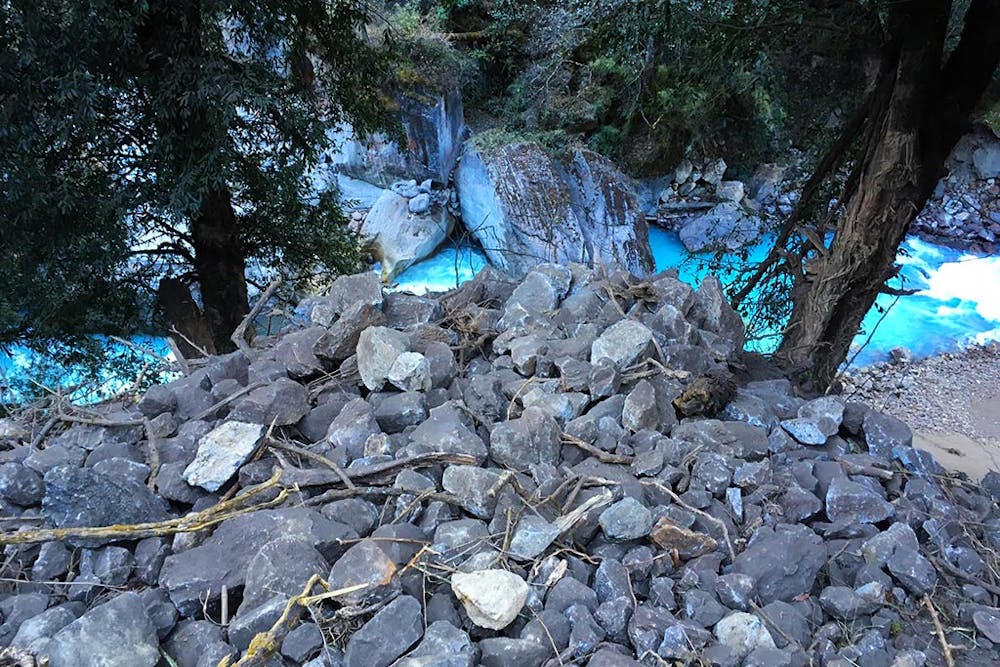Manaslu Circuit Trek Report Post Earthquake

The Manaslu circuit trekking route was severely affected by the massive earthquake of April 2015. The epicentre of that devastating earthquake was in Gorkha District, where Mount Manaslu – the world’s 8th highest mountain is located. So you must be wondering and asking the question, can I still do Manaslu Circuit trekking after the earthquake? We decided to do the trek ourselves and write a first-hand report on the trail condition.

We did this trek from 4th – 17th December 2016. We were blessed with perfect weather during the trek, where the views were clear throughout. We found that most of the damage on the villages and trails were either repaired or rebuilt. In addition, the Nepal government has installed new bridges and walkways. However, in certain parts of the path where landslides occurred during the earthquake, we noticed huge boulders coming down the trail and onto the Buri Gandaki River.
Road construction is going on to reach Larke La pass to connect with the Manang district. However, the construction of roads requires blasting off part of the hills, removing huge boulders, destabilising the mountain, and making it susceptible to landslides for several years.

During late September, at the tail end of the monsoon, a group of trekkers and their support crew were caught in a landslide when three Nepali crew members, including the company owner, a guide, and a trekker, were killed; just a few minutes walk away from Tatopani (hot springs). This landslide had settled when we crossed it, but it could get active when it rains or the next monsoon. Landslides usually take a couple of years or more to settle ultimately.
We observed a new menace was the increased number of mules plying on the trail. Despite December being off-season, the mules were used to resupply the lodges for the coming spring season. The paths are narrow, with some harrowing drops into the Buri Gandaki River. Additionally, some of the mule drivers make the mules trot while returning to the road head at Soti Khola, which can be menacing to the trekkers on the narrow trails. It is best to listen to the bells’ sounds of approaching mule caravans as a warning – so it is best not to listen to music with earphones while trekking. There are close to 2000 mules used to carry supplies to the villages along the Manaslu Circuit and Tsum Valley.
We saw a new and dangerous landslide on our hike to Gap with no warning. There was a potential of falling into the raging Buri Gandaki River a couple of hundred meters below. Our porters who got to this landslide managed to get past this landslide with much difficulty. Every few steps they took forward, they slid a few steps back. Had it not been for their steady foot, there could have been some injuries or worse.

While we were in Samdo, the lodge owner’s husband drives mules to supply the villages and called to inform his wife that a fresh dry landslide had cut off the trail. Unfortunately, this landslide took place close to Lapu Besi, where we had lunch on day 1 of our trek. Hence his arrival was delayed until the path was reopened.
On the last day of our trek, we started from the village of Gowa. After a short walk past the village, we came upon a detour; we checked out what seemed like an alternative route to find that it went next to the raging Dudh River. We retraced our steps and passed the blocked trail to find ourselves in another landslide. Having negotiated our way across initially, we had to scramble back up to make it to a ridge we had not been able to see previously – a new road that had been constructed. It was quite a nerve-wracking experience until we reached more solid ground. There should have been a clear sign directing trekkers to the newly built road, or the lodge owners could have informed us of this matter.

I hope the concerned authorities or departments will immediately rebuild the trail and signs and provide proper maintenance. Anyway, all is well that ends well.
Text: Raj Tamang
Photo Courtesy: Tara Austin
Check out our Trekking packages for Nepal, Bhutan, India, and Tibet.
